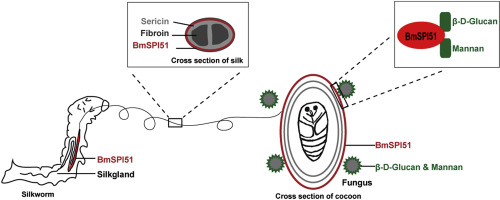当前位置:
X-MOL 学术
›
Insect Biochem. Mol. Biol.
›
论文详情
Our official English website, www.x-mol.net, welcomes your
feedback! (Note: you will need to create a separate account there.)
Kunitz-type protease inhibitor BmSPI51 plays an antifungal role in the silkworm cocoon.
Insect Biochemistry and Molecular Biology ( IF 3.2 ) Pub Date : 2019-10-31 , DOI: 10.1016/j.ibmb.2019.103258 Xiaolu Zhang 1 , Kaiyu Guo 1 , Zhaoming Dong 2 , Zhiyong Chen 1 , Hongtao Zhu 1 , Yan Zhang 2 , Qingyou Xia 2 , Ping Zhao 2
Insect Biochemistry and Molecular Biology ( IF 3.2 ) Pub Date : 2019-10-31 , DOI: 10.1016/j.ibmb.2019.103258 Xiaolu Zhang 1 , Kaiyu Guo 1 , Zhaoming Dong 2 , Zhiyong Chen 1 , Hongtao Zhu 1 , Yan Zhang 2 , Qingyou Xia 2 , Ping Zhao 2
Affiliation

|
The protease inhibitors found in silkworm cocoons can be divided into several families, a majority of which contain serpin, TIL, or Kunitz domains. Previously, it has been reported that TIL-type protease inhibitors have antimicrobial activity. To date, however, it has not been determined whether the Kunitz-type protease inhibitor BmSPI51, the most abundant of cocoon protease inhibitors, plays an antimicrobial role. Thus, in this study, we sought to determine the biological role of BmSPI51 in silkworm cocoons. Our results obtained from real-time quantitative reverse transcription PCR and immunofluorescence analyses indicate that BmSPI51 is expressed exclusively in the silk glands during the larval fifth instar stage and is subsequently secreted into cocoon silk. Moreover, at a molar ratio of 1:1, BmSPI51 produced via prokaryotic expression exhibited inhibitory activity against trypsin and also proved to be highly stable over wide ranges of temperature and pH values. The expression of BmSPI51 was also found to be significantly upregulated in the larval fat body after infection with three species of fungi, namely, Candida albicans, Beauveria bassiana, and Saccharomyces cerevisiae. In vitro inhibition tests revealed that BmSPI51 significantly inhibited the sporular growth of all three of these fungal species. Further, results obtained from a binding assay showed that BmSPI51 binds to β-d-glucan and mannan on the surface of fungal cells. In this study, we, thus, revealed the antimicrobial activity of BmSPI51 and its underlying mechanism in silkworm, thereby contributing to our present understanding of defense mechanisms in silkworm cocoons.
中文翻译:

Kunitz型蛋白酶抑制剂BmSPI51在蚕茧中发挥抗真菌作用。
家蚕茧中发现的蛋白酶抑制剂可分为几个家族,其中大多数包含丝氨酸蛋白酶抑制剂(serpin),TIL或Kunitz域。以前,已经报道了TIL型蛋白酶抑制剂具有抗微生物活性。然而,迄今为止,尚未确定最丰富的茧型蛋白酶抑制剂Kunitz型蛋白酶抑制剂BmSPI51是否发挥抗菌作用。因此,在这项研究中,我们试图确定BmSPI51在蚕茧中的生物学作用。我们从实时定量逆转录PCR和免疫荧光分析获得的结果表明,BmSPI51在幼虫第五龄阶段仅在丝腺中表达,随后被分泌到茧丝中。此外,摩尔比为1:1时,通过原核表达产生的BmSPI51表现出对胰蛋白酶的抑制活性,并且还被证明在很宽的温度和pH值范围内高度稳定。在感染了三种念珠菌,白色念珠菌,球孢白僵菌和酿酒酵母三种真菌后,幼虫脂肪体中的BmSPI51的表达也被显着上调。体外抑制试验表明,BmSPI51显着抑制了所有这三种真菌物种的孢子生长。此外,从结合试验获得的结果表明,BmSPI51与真菌细胞表面上的β-d-葡聚糖和甘露聚糖结合。因此,在这项研究中,我们揭示了BmSPI51的抗菌活性及其在家蚕中的潜在机制,从而有助于我们对家蚕茧防御机制的当前了解。
更新日期:2019-10-31
中文翻译:

Kunitz型蛋白酶抑制剂BmSPI51在蚕茧中发挥抗真菌作用。
家蚕茧中发现的蛋白酶抑制剂可分为几个家族,其中大多数包含丝氨酸蛋白酶抑制剂(serpin),TIL或Kunitz域。以前,已经报道了TIL型蛋白酶抑制剂具有抗微生物活性。然而,迄今为止,尚未确定最丰富的茧型蛋白酶抑制剂Kunitz型蛋白酶抑制剂BmSPI51是否发挥抗菌作用。因此,在这项研究中,我们试图确定BmSPI51在蚕茧中的生物学作用。我们从实时定量逆转录PCR和免疫荧光分析获得的结果表明,BmSPI51在幼虫第五龄阶段仅在丝腺中表达,随后被分泌到茧丝中。此外,摩尔比为1:1时,通过原核表达产生的BmSPI51表现出对胰蛋白酶的抑制活性,并且还被证明在很宽的温度和pH值范围内高度稳定。在感染了三种念珠菌,白色念珠菌,球孢白僵菌和酿酒酵母三种真菌后,幼虫脂肪体中的BmSPI51的表达也被显着上调。体外抑制试验表明,BmSPI51显着抑制了所有这三种真菌物种的孢子生长。此外,从结合试验获得的结果表明,BmSPI51与真菌细胞表面上的β-d-葡聚糖和甘露聚糖结合。因此,在这项研究中,我们揭示了BmSPI51的抗菌活性及其在家蚕中的潜在机制,从而有助于我们对家蚕茧防御机制的当前了解。









































 京公网安备 11010802027423号
京公网安备 11010802027423号